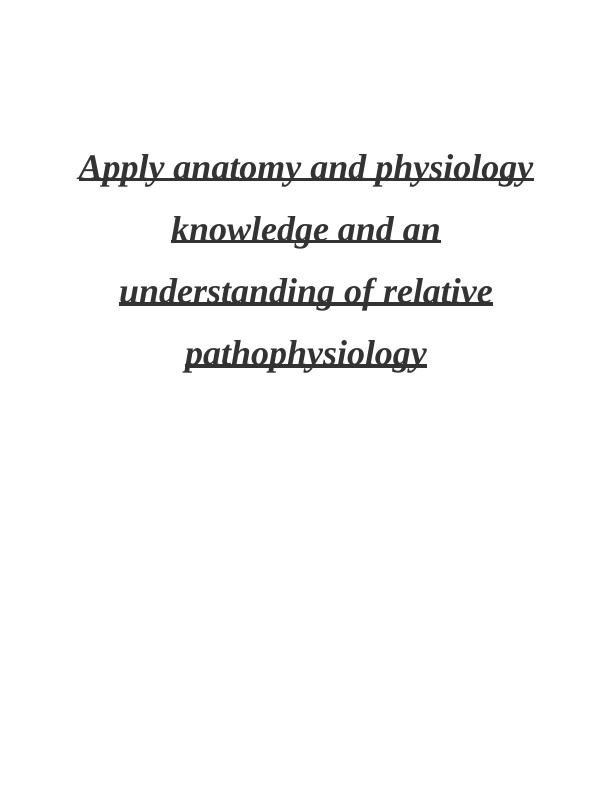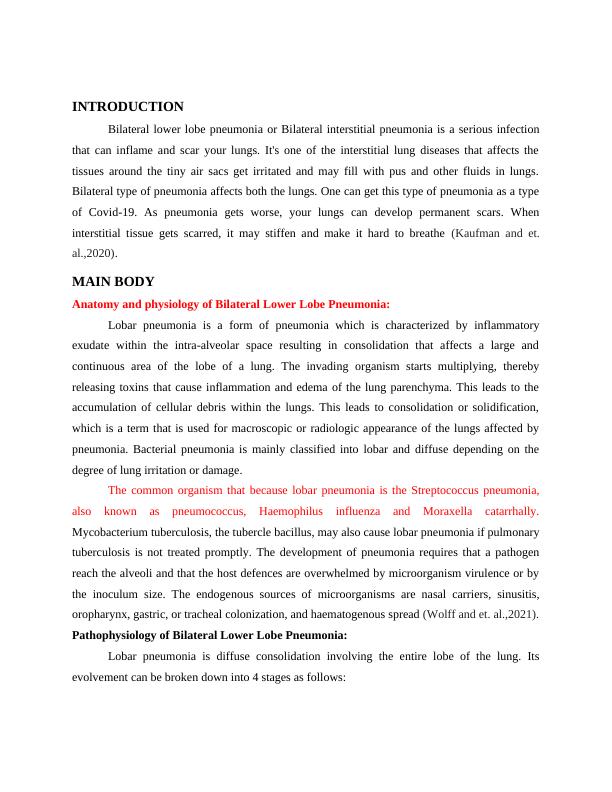Anatomy and Physiology of Bilateral Lower Lobe Pneumonia
Added on 2023-06-10
4 Pages778 Words300 Views
Apply anatomy and physiology
knowledge and an
understanding of relative
pathophysiology
knowledge and an
understanding of relative
pathophysiology

INTRODUCTION
Bilateral lower lobe pneumonia or Bilateral interstitial pneumonia is a serious infection
that can inflame and scar your lungs. It's one of the interstitial lung diseases that affects the
tissues around the tiny air sacs get irritated and may fill with pus and other fluids in lungs.
Bilateral type of pneumonia affects both the lungs. One can get this type of pneumonia as a type
of Covid-19. As pneumonia gets worse, your lungs can develop permanent scars. When
interstitial tissue gets scarred, it may stiffen and make it hard to breathe (Kaufman and et.
al.,2020).
MAIN BODY
Anatomy and physiology of Bilateral Lower Lobe Pneumonia:
Lobar pneumonia is a form of pneumonia which is characterized by inflammatory
exudate within the intra-alveolar space resulting in consolidation that affects a large and
continuous area of the lobe of a lung. The invading organism starts multiplying, thereby
releasing toxins that cause inflammation and edema of the lung parenchyma. This leads to the
accumulation of cellular debris within the lungs. This leads to consolidation or solidification,
which is a term that is used for macroscopic or radiologic appearance of the lungs affected by
pneumonia. Bacterial pneumonia is mainly classified into lobar and diffuse depending on the
degree of lung irritation or damage.
The common organism that because lobar pneumonia is the Streptococcus pneumonia,
also known as pneumococcus, Haemophilus influenza and Moraxella catarrhally.
Mycobacterium tuberculosis, the tubercle bacillus, may also cause lobar pneumonia if pulmonary
tuberculosis is not treated promptly. The development of pneumonia requires that a pathogen
reach the alveoli and that the host defences are overwhelmed by microorganism virulence or by
the inoculum size. The endogenous sources of microorganisms are nasal carriers, sinusitis,
oropharynx, gastric, or tracheal colonization, and haematogenous spread (Wolff and et. al.,2021).
Pathophysiology of Bilateral Lower Lobe Pneumonia:
Lobar pneumonia is diffuse consolidation involving the entire lobe of the lung. Its
evolvement can be broken down into 4 stages as follows:
Bilateral lower lobe pneumonia or Bilateral interstitial pneumonia is a serious infection
that can inflame and scar your lungs. It's one of the interstitial lung diseases that affects the
tissues around the tiny air sacs get irritated and may fill with pus and other fluids in lungs.
Bilateral type of pneumonia affects both the lungs. One can get this type of pneumonia as a type
of Covid-19. As pneumonia gets worse, your lungs can develop permanent scars. When
interstitial tissue gets scarred, it may stiffen and make it hard to breathe (Kaufman and et.
al.,2020).
MAIN BODY
Anatomy and physiology of Bilateral Lower Lobe Pneumonia:
Lobar pneumonia is a form of pneumonia which is characterized by inflammatory
exudate within the intra-alveolar space resulting in consolidation that affects a large and
continuous area of the lobe of a lung. The invading organism starts multiplying, thereby
releasing toxins that cause inflammation and edema of the lung parenchyma. This leads to the
accumulation of cellular debris within the lungs. This leads to consolidation or solidification,
which is a term that is used for macroscopic or radiologic appearance of the lungs affected by
pneumonia. Bacterial pneumonia is mainly classified into lobar and diffuse depending on the
degree of lung irritation or damage.
The common organism that because lobar pneumonia is the Streptococcus pneumonia,
also known as pneumococcus, Haemophilus influenza and Moraxella catarrhally.
Mycobacterium tuberculosis, the tubercle bacillus, may also cause lobar pneumonia if pulmonary
tuberculosis is not treated promptly. The development of pneumonia requires that a pathogen
reach the alveoli and that the host defences are overwhelmed by microorganism virulence or by
the inoculum size. The endogenous sources of microorganisms are nasal carriers, sinusitis,
oropharynx, gastric, or tracheal colonization, and haematogenous spread (Wolff and et. al.,2021).
Pathophysiology of Bilateral Lower Lobe Pneumonia:
Lobar pneumonia is diffuse consolidation involving the entire lobe of the lung. Its
evolvement can be broken down into 4 stages as follows:

End of preview
Want to access all the pages? Upload your documents or become a member.
Related Documents
Pneumonia: Causes, Pathophysiology, Symptoms, and Treatment Optionslg...
|8
|1716
|315
Shortness of Breath | Case Studylg...
|2
|659
|15